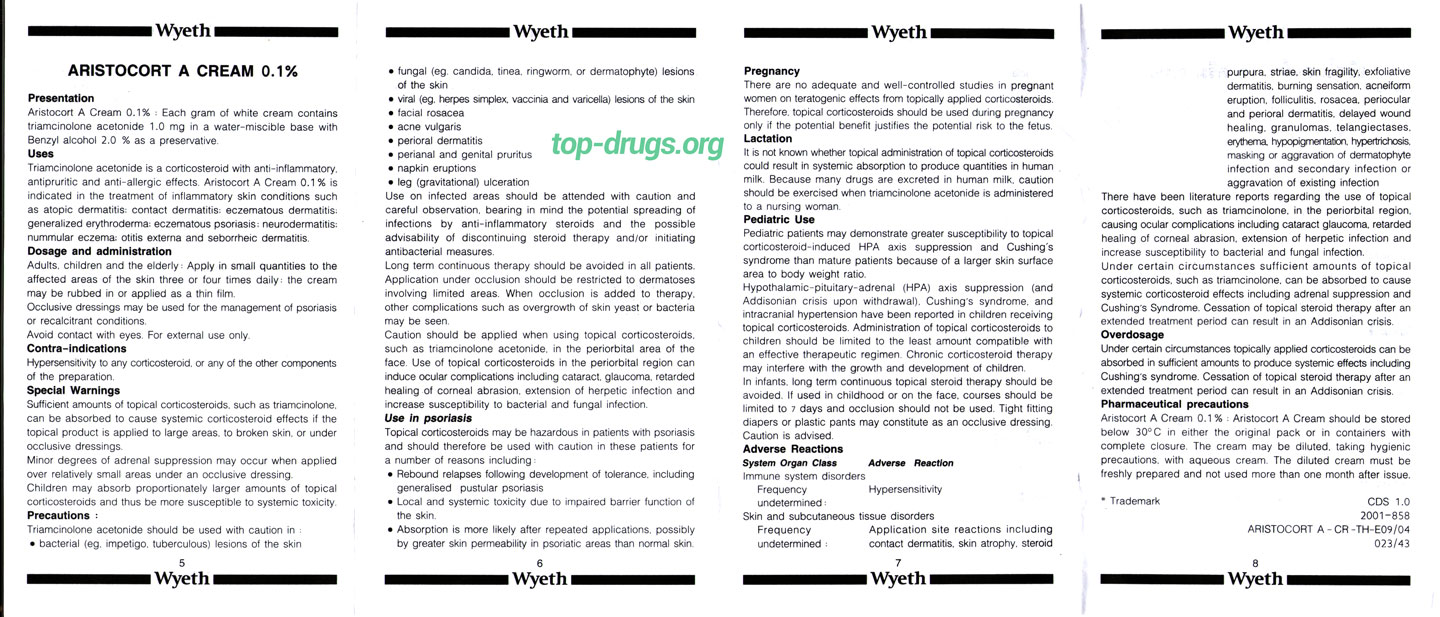ARISTOCORT A CREAM 0.1%
Presentation
Aristocort A Cream 0.1% : Each gram of white cream contains triamcinolone acetonide 1.0 mg in a water—miscible base with Benzyl alcohol 2.0 % as a preservative.
Uses
Triamcinolone acetonide is a corticosteroid with anti—inflammatory. antipruritic and anti—allergic effects. Aristocort A Cream 0.1% is indicated in the treatment of inflammatory skin conditions such as atopic dermatitis: contact dermatitis: eczematous dermatitis; generalized erythroderma: eczematous psoriasis: neurodermatitis; nummular eczema: otitis externa and seborrheic dermatitis.
Dosage and administration
Adults, children and the elderly: Apply in small quantities to the affected areas of the skin three or four times daily: the cream may be rubbed in or applied as a thin film.
Occlusive dressings may be used for the management of psoriasis
or recalcitrant conditions.
Avoid contact with eyes. For external use only.
Contra—indications
Hypersensitivity to any corticosteroid. or any of the other components of the preparation.
Special Warnings
Sufficient amounts of topical corticosteroids. such as triamcinolone. can be absorbed to cause systemic corticosteroid effects if the topical product is applied to large areas. to broken skin. or under occlusive dressings.
Minor degrees of adrenal suppression may occur when applied over relatively small areas under an occlusive dressing. Children may absorb proportionately larger amounts of topical corticosteroids and thus be more susceptible to systemic toxicity.
Precautions :
Triamcinolone acetonide should be used with caution in :
- bacterial (eg. impetigo. tuberculous) lesions of the skin
- fungal (eg. candida, tinea, ringworm. or dermatophyte) lesions of the skin
- viral (eg. herpes simplex. vaccinia and varicella) lesions of the skin
- facial rosacea
- acne vulgaris
- perioral dermatitis
- perianal and genital pruritus
- napkin eruptions
- leg (gravitational) ulceration
Use on infected areas should be attended with caution and careful observation. bearing in mind the potential spreading of infections by anti—inflammatory steroids and the possible advisability of discontinuing steroid therapy and/or initiating antibacterial measures.
Long term continuous therapy should be avoided in all patients. Application under occlusion should be restricted to dermatoses involving limited areas. When occlusion is added to therapy. other complications such as overgrowth of skin yeast or bacteria may be seen.
Caution should be applied when using topical corticosteroids. such as triamcinolone acetonide, in the periorbital area of the face. Use of topical corticosteroids in the periorbital region can induce ocular complications including cataract, glaucoma. retarded healing of corneal abrasion. extension of herpetic infection and increase susceptibility to bacterial and fungal infection.
Use in psoriasis
Topical corticosteroids may be hazardous in patients with psoriasis and should therefore be used with caution in these patients for a number of reasons including:
- Rebound relapses following development of tolerance, including generalised pustular psoriasis
- Local and systemic toxicity due to impaired barrier function of the skin.
- Absorption is more likely after repeated applications. possibly by greater skin permeability in psoriatic areas than normal skin.
Pregnancy
There are no adequate and well—controlled studies in pregnant women on teratogenic effects from topically applied corticosteroids. Therefore. topical corticosteroids should be used during pregnancy only if the potential benefit justifies the potential risk to the fetus.
Lactation
It is not known whether topical administration of topical corticosteroids could result in systemic absorption to produce quantities in human milk. Because many drugs are excreted in human milk. caution should be exercised when triamcinolone acetonide is administered to a nursing woman.
Pediatric Use
Pediatric patients may demonstrate greater susceptibility to topical corticosteroid—induced HPA axis suppression and Cushing’s syndrome than mature patients because of a larger skin surface area to body weight ratio.
Hypothalamic—pituitary—adrenal (HPA) axis suppression (and Addisonian crisis upon withdrawal). Cushing’s syndrome. and intracranial hypertension have been reported in children receiving topical corticosteroids. Administration of topical corticosteroids to children should be limited to the least amount compatible with an effective therapeutic regimen. Chronic corticosteroid therapy may interfere with the growth and development of children. In infants. long term continuous topical steroid therapy should be avoided. If used in childhood or on the face, courses should be limited to 7 days and occlusion should not be used. Tight fitting diapers or plastic pants may constitute as an occlusive dressing.
Caution is advised.
Adverse Reactions
System Organ Class
Immune system disorders
Frequency : Hypersensitivity
undetermined : –
Skin and subcutaneous tissue disorders
Frequency : Application site reactions including
undetermined :
contact dermatitis. skin atrophy. steroid purpura. striae. skin fragility. exfoliative dermatitis. burning sensation. acneiform eruption, folliculitis. rosacea. periocular and perioral dermatitis, delayed wound healing. granulomas, telangiectases. erythema, hypopigmentation. hypertrichosis. masking or aggravation of dermatophyte infection and secondary infection or aggravation of existing infection
There have been literature reports regarding the use of topical corticosteroids. such as triamcinolone. in the periorbital region.
causing ocular complications including cataract glaucoma. retarded healing of corneal abrasion, extension of herpetic infection and increase susceptibility to bacterial and fungal infection.
Under certain circumstances sufficient amounts of topical corticosteroids. such as triamcinolone, can be absorbed to cause
systemic corticosteroid effects including adrenal suppression and Cushing’s Syndrome. Cessation of topical steroid therapy after an extended treatment period can result in an Addisonian crisis.
Overdosage
Under certain circumstances topically applied corticosteroids can be absorbed in sufficient amounts to produce systemic effects including Cushing’s syndrome. Cessation of topical steroid therapy after an extended treatment period can result in an Addisonian crisis.
Pharmaceutical precautions
Aristocort A Cream 0.1 % : Aristocort A Cream should be stored below 30°C in either the original pack or in containers with complete closure. The cream may be diluted, taking hygienic precautions. with aqueous cream. The diluted cream must be freshly prepared and not used more than one month after issue.
Trademark CDS 1.0
2001-858
ARISTOCORT A — CR —TH—E09/O4
023/ 43

Leave a Reply